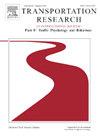A unified driving behavior model based on psychological safety space
IF 3.5
2区 工程技术
Q1 PSYCHOLOGY, APPLIED
Transportation Research Part F-Traffic Psychology and Behaviour
Pub Date : 2025-02-01
DOI:10.1016/j.trf.2024.12.024
引用次数: 0
Abstract
Almost all traffic phenomena are influenced by driving behavior, making the understanding and description of driving behavior a key aspect of traffic research. Traditional driving behavior models, such as car-following and lane-changing models, are often confined to specific scenarios, thus limiting their applicability across diverse driving conditions. This study aims to analyze the underlying mechanisms of human drivers’ decision-making in diverse driving contexts and develop a unified driving behavior model suitable for a wide range of situations. By integrating situational awareness theory with personal space theory, the concept of Psychological Safety Space (PSS) is defined and its boundaries are quantified using risk field theory. A unified driving behavior model is then developed based on psychological safety space, incorporating a spatial trajectory planning algorithm and a speed regulation algorithm. The proposed model is evaluated against classical models, including the intelligent driver model, desired risk model, and desired safety margin model, as well as empirical data. The results demonstrate that the driving behavior model based on psychological safety space achieves high accuracy and effectiveness in scenarios such as car-following, lane-changing, and intersection navigation. This study offers new perspectives and methods for understanding and simulating driver behavior and contributes to the advancement of driving behavior model development.
基于心理安全空间的统一驾驶行为模型
几乎所有的交通现象都受到驾驶行为的影响,因此对驾驶行为的理解和描述是交通研究的一个重要方面。传统的驾驶行为模型,如汽车跟随和变道模型,往往局限于特定的场景,从而限制了它们在不同驾驶条件下的适用性。本研究旨在分析人类驾驶员在不同驾驶环境下的决策机制,建立适用于多种情况的统一驾驶行为模型。将情境感知理论与个人空间理论相结合,定义了心理安全空间的概念,并运用风险场理论量化了心理安全空间的边界。结合空间轨迹规划算法和速度调节算法,建立了基于心理安全空间的统一驾驶行为模型。通过对智能驾驶员模型、期望风险模型和期望安全裕度模型等经典模型以及经验数据进行了评价。结果表明,基于心理安全空间的驾驶行为模型在车辆跟随、变道、十字路口导航等场景下具有较高的准确性和有效性。本研究为理解和模拟驾驶员行为提供了新的视角和方法,有助于推动驾驶行为模型的发展。
本文章由计算机程序翻译,如有差异,请以英文原文为准。
求助全文
约1分钟内获得全文
求助全文
来源期刊
CiteScore
7.60
自引率
14.60%
发文量
239
审稿时长
71 days
期刊介绍:
Transportation Research Part F: Traffic Psychology and Behaviour focuses on the behavioural and psychological aspects of traffic and transport. The aim of the journal is to enhance theory development, improve the quality of empirical studies and to stimulate the application of research findings in practice. TRF provides a focus and a means of communication for the considerable amount of research activities that are now being carried out in this field. The journal provides a forum for transportation researchers, psychologists, ergonomists, engineers and policy-makers with an interest in traffic and transport psychology.

 求助内容:
求助内容: 应助结果提醒方式:
应助结果提醒方式:


